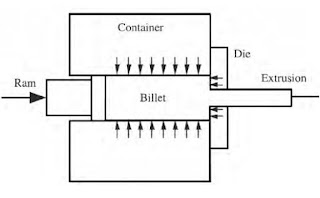Extrusion is a compressive deformation process. In this process confining the metal is formed in a closed cavity and then allowing it to flow from only one opening so that metal takes the shape of the opening. The operation is identical to the squeezing of toothpaste out of toothpaste tube.
In an extrusion process, a material is pushed through the die of the desired cross-section so it creates the object of fixed-cross section profile that what we need because of this its ability to create very complex cross-sectional area and it also works for brittle material.
Extrusions can be either very thick in cross-section or very thin and can be either solid or hollow with the proper tooling, extrusions may be tapered or stepped.
The remaining extruded stock after finishing the forging process is then cut to convenient stock size and used as specific products, assembly components or as raw stock material for further processing.
The equipment consists of a cylinder or container in which the billet is loaded with the heated metal. On one end of the container, the die plate with the necessary opening is fixed. From the other end, a plunger or ram compresses the metal billet against the container walls and the die plate, thus forcing it to flow through the die opening, and acquiring the shape of the opening. The extrude metal is then carried by the metal-handling system as it comes out of the die.
By the extrusion process, it is possible to make components which have a constant cross-section over any length as can be had by the rolling process. Also, extrusion is a single-pass process unlike rolling. Generally, brittle materials can also be very easily extruded. It is possible to produce sharp corners and re-entrant angles.
It is the ratio of the area of a cross-section of the billet to the area of a cross-section of the extruded material.
The parameter used in extrusion is shape factor, the ratio of perimeter to the cross-section of the part. An extruded rod has the lowest shape factor.
The typical extrusion ratio values are between 20 to 50. Low extrusion ratios are used for intermediate operations when the billets are extruded to a given diameter before the final extrusion.
In an extrusion process, a material is pushed through the die of the desired cross-section so it creates the object of fixed-cross section profile that what we need because of this its ability to create very complex cross-sectional area and it also works for brittle material.
Extrusions can be either very thick in cross-section or very thin and can be either solid or hollow with the proper tooling, extrusions may be tapered or stepped.
The remaining extruded stock after finishing the forging process is then cut to convenient stock size and used as specific products, assembly components or as raw stock material for further processing.
Extrusion process working principle:
The equipment consists of a cylinder or container in which the billet is loaded with the heated metal. On one end of the container, the die plate with the necessary opening is fixed. From the other end, a plunger or ram compresses the metal billet against the container walls and the die plate, thus forcing it to flow through the die opening, and acquiring the shape of the opening. The extrude metal is then carried by the metal-handling system as it comes out of the die.
By the extrusion process, it is possible to make components which have a constant cross-section over any length as can be had by the rolling process. Also, extrusion is a single-pass process unlike rolling. Generally, brittle materials can also be very easily extruded. It is possible to produce sharp corners and re-entrant angles.
What is the extrusion ratio?
It is the ratio of the area of a cross-section of the billet to the area of a cross-section of the extruded material.
R = Ao / Af
The typical extrusion ratio values are between 20 to 50. Low extrusion ratios are used for intermediate operations when the billets are extruded to a given diameter before the final extrusion.
The extrusion process is used for manufacturing long and straight metal parts with the shape of solid round, rectangular, T shapes, L shapes, and tubes.
Extrusion speed depends on the work material. Some light alloys may be extruded at a speed of 0.05 m/s, whereas for copper alloys it may be as high as 4.50 m/s. Too high an extrusion speed causing lateral cracks because of excessive heat generation in the extruded metal.
Extrusion process mainly divide into two types one is hot extrusion and the other is cold extrusion.
Hot extrusion :
Extrusion speed depends on the work material. Some light alloys may be extruded at a speed of 0.05 m/s, whereas for copper alloys it may be as high as 4.50 m/s. Too high an extrusion speed causing lateral cracks because of excessive heat generation in the extruded metal.
Classification of the extrusion process:
Extrusion process mainly divide into two types one is hot extrusion and the other is cold extrusion.
Hot extrusion :
- Forward hot extrusion
- Backward hot extrusion
Cold extrusion :
- Forward cold extrusion
- Backward cold extrusion
In backward cold extrusion also two subtype one is cold extrusion forging and other is impact extrusion.
Explore more information:
Explore more information:
